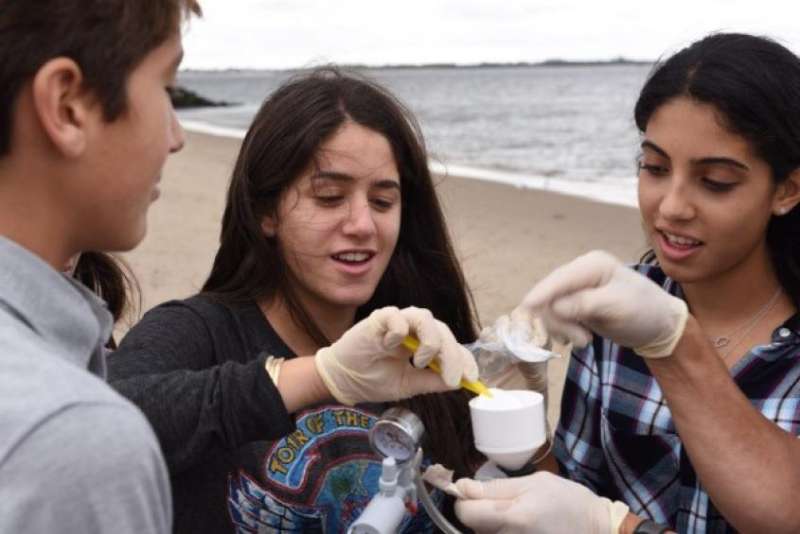Brooklyn students collect water samples to test for the presence of invasive species. Credit: Cornell University
Invasive aquatic species like round goby, Asian carp, and sea lamprey are a growing problem in New York State. Their presence impacts water quality, food supply, recreation and tourism, as well as human and animal health. Early detection is a critical first step in monitoring a species' spread and managing responses.
Scientists at Cornell University's College of Veterinary Medicine have devised genetic tests that can detect the environmental DNA (eDNA) of invasive species in a waterway before they become established there. But there are more than 7,600 freshwater lakes and ponds and over 70,000 miles of rivers and streams in New York State, all of them potential conduits for the unwelcome species. How can the Cornell team watch them all for signs of a potential invasion? The answer: teams of young citizen scientists from schools located near a lake, river, or creek, who gather water samples to send to Cornell for analysis.
Dr. Donna Cassidy-Hanley, a senior research associate at the Cornell Veterinary College, had already worked with teachers across New York state to provide hands-on resources for teaching basic science. Teaming up with Cornell Professor James Casey, who developed the genetic tests, Cassidy-Hanley went back to those teachers with a new proposal: Engage your students in a hands-on research project with Cornell scientists that introduces them to invasive species, ecology, environmental management, and bio-informatics, and that has important real world impact.
The response has been amazing. "We had hoped to get five or six teachers involved in the pilot program," says Hanley-Cassidy. "We currently have 60 teachers across the state." Students at schools from New York City to small rural upstate towns have joined in the effort to monitor the spread of invasive fish, contributing critical data and learning about science firsthand.
Cornell sends participating classes free kits containing everything needed to collect water samples. Sample collection starts in the spring as soon as the ice melts and continues until the waters freeze in the fall. Cornell shares detailed test results with teachers and students as soon as the analyses are complete, providing a platform for further learning and discussion. Some classes travel to Cornell to see the laboratory where their samples are tested.
Casey is impressed with the quality of the samples. "I was surprised at how well the program works," he says. "Round goby have been identified at 38 separate sites across the state, including two sites in areas where round goby had not previously been found." The program is supported in part by a USDA HATCH grant, which covers activities in New York state. Word is spreading and teachers from other states are expressing interest in the possibility of similar program,The feedback from teachers and students is very encouraging. Student interest is high, even among students with little past interest in science, and extracurricular groups like ecology clubs have become involved. "Activities like this can have a game changing influence on attitudes and interests," Cassidy-Hanley says. "Seeing firsthand how invasives can affect fishing and boating, as well as the environment and the economy, helps students understand that science has a real impact on daily life."
Maps that show participants and test results across the state can be seen by visiting tetrahymenaasset.vet.cornell.e … dna-testing-results/ . The map on that page is not interactive, but the four species-specific links above it connect to maps that are.
Provided by Cornell University
























